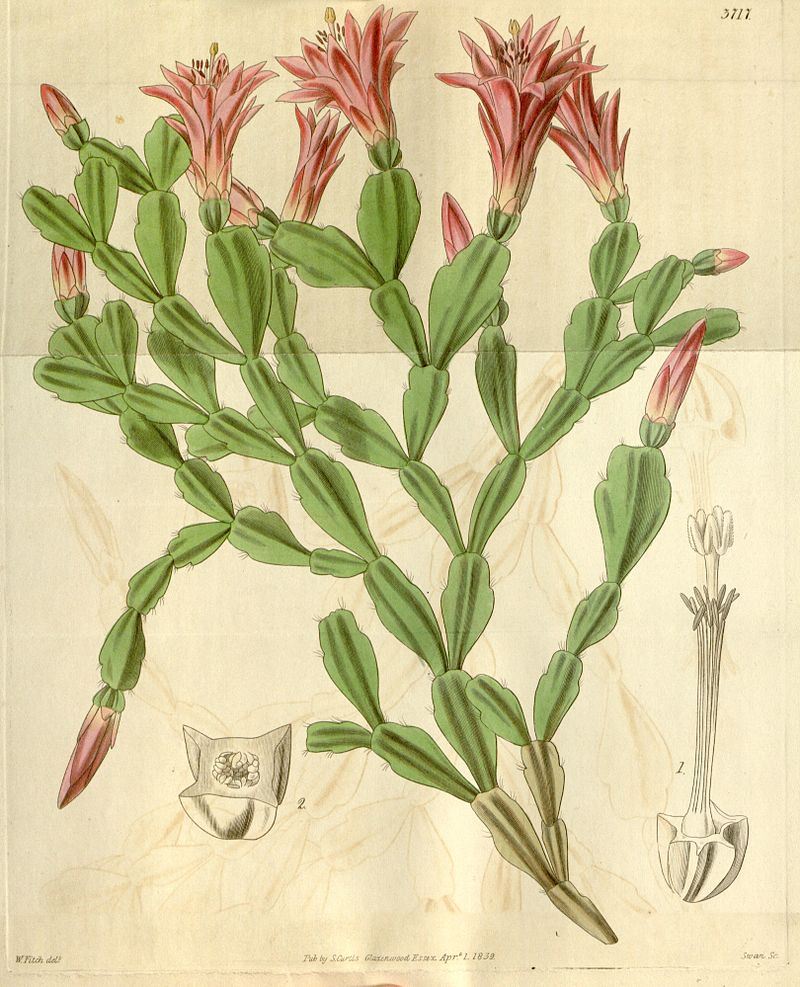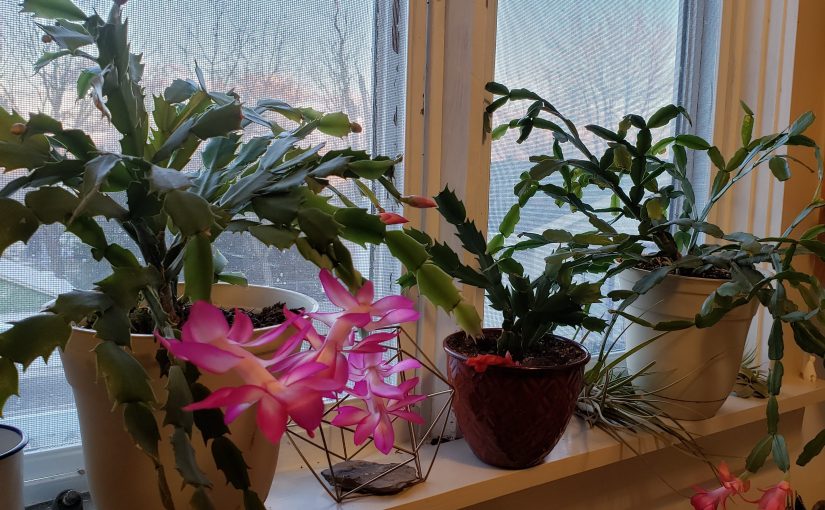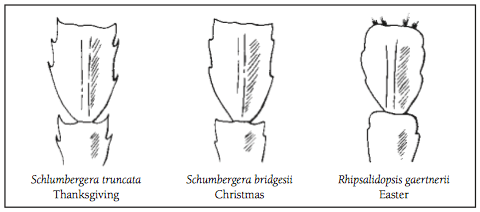Believe it or not, a cactus, of all things, is one of those plants that have come to represent the holidays and feature in the regular rotation of holiday houseplants. Then again, maybe it isn’t so strange amongst its peers that feature a flashy bulb-grown plant named for a horse’s head (the Latin name of amaryllis is Hippeastrum, literally meaning horse flower), a plant that has ugly flowers but brightly colored leaf bracts and leaks sticky and irritating latex when damaged, or some daffodil-like flowers that have musky odor so strong it makes some people nauseous. But…..I digress.
Back to the cactus. However you see it though, the cacti that make their debut at the holidays are suffering under a case of mistaken identity. What you typically buy as a Christmas cactus is not a Christmas cactus at all. It is actually a Thanksgiving cactus. Now this wouldn’t be such a big deal, except that there is such a thing as a “Christmas cactus” — but you won’t find one on store shelves. Nay, it is hard to even find one in garden catalogs. And this is sad, because the Christmas cactus is, I think, even more beautiful than the Thanksgiving cactus.
How did we end up ignoring the beautiful Christmas cactus in favor of its holiday cousin? It all comes down to timing and how we buy things for the holidays. It seems that, as the shopping and holiday seasons creep ever upward on the calendar, retailers have little love for a cactus that is actually programmed to bloom at Christmas. They need something that blooms earlier so that it can be on the store shelves as early as possible. (At this pace, breeders will need to develop and Independence Day cactus for the Christmas shopping season.)
Therefore, the
Thanksgiving cactus has been rebranded as a impostor stand-in for the
true Christmas cactus. We won’t even talk about the Easter cactus, which just
totally feels left out of the family (and yes, there is such a thing and it is
beautiful).
These cacti were in cultivation in Europe by 1818 and various different species were being hybridized, probably most notably by W. Buckley. The most notable hybrid, bred now named Schlumbergera ‘Buckleyi’ is considered to be the first actual “Christmas cactus” and associated S. x buckleyi hybrids are still grown as Christmas cacti. Cultivars and crosses of S. truncata are the Thanksgiving cacti that have been rebranded as Christmas cacti. They can be identified by their flattened stems (or cladodes or cladophylls) that have spiky, toothed edges and zygomorphic (now that’s a fancy word — it means that they have a two-sided, or bilateral, symmetry) flowers. Most of the Thanksgiving cacti that have these characteristics.

You’ll most commonly find them in pink colors, but you can now find them in yellowish colors. The flower shape often leads to its nickname: “Zygo cactus.”
S. x buckleyi are the true Christmas cacti and form what is called the Buckleyi group. Most of these have characteristics that come from the species S. russelliana, which was used in the early Buckley crosses. They can be identified by their rounded, less pointy cladodes and round, radially symmetrical flowers. They do have a similar growing form, but those in the know can tell the difference.
And for those following along at home, the Easter (or spring) cactus used to be considered part of the Schlumbergera genus (S. gaertneri) and then the Rhipsalidopsis genus, but now is classified as Hatiora gaertneri has radially symmetrical flowers but the cladodes are three dimensional rather than flat, elongated, and scalloped. They have a wide range of colors, such as red, pink, and even orange.
Holiday cactus care
It’s a cactus, so it should be easy to care for – I just water it sparingly and keep it dry, right? WRONG!
Whether you have a Thanksgiving or Christmas cactus (or an Easter one, for that matter), you take care of them the same way. Keys to their care come from their native habitat, which is not a desert but the cloud forests of costal south-east Brazil. The high-altitude costal areas where they’re from are cool, shaded, and relatively humid with the mists and moisture rich air. They are epiphytic or lithophytic – meaning that they grow on trees and in crevices with decaying plant material rather than in the soil. And while you don’t need to know this to grow them, the morphology of the flowers have developed to support the feeding of hummingbirds which act as their main pollinator.

Schlumbergera x buckleyi
Christmas cactus
Schlumbergera truncata
Thanksgiving cactus
Hatiora gaetneri
Easter cactus
Since we don’t grow them epiphytically, when we pot them we need to make sure that we provide a light substrate for them to grow and to get plenty of oxygen to the roots. Potting mixes should have a high ratio of peat or coir and even some bark or other coarse woody material. As for watering, you’ll want to keep the soil fairly moist, rather than dry. You’ll also want to let them dry slightly between watering, but don’t think that they like to live the life of dehydration — you do need to keep them watered.
One of the reasons that they bloom at very specific time of year has to do with light and, to a lesser extent, temperature. They are short-day (or rather long-night) plants, so they flower as days grow shorter (or longer, in the case of the Easter cactus) and nights grow longer. The Thanksgiving cactus will bloom with just a little shorter dark period than the Christmas cactus, which is why it blooms in late fall as opposed to the Christmas cactus that blooms closer to when days are the shortest around the solstice. They will also bloom better and longer if they have cooler temperatures, so keeping them in a cool area of the house is ideal. In high light situations the cladodes will turn red. Keeping them too dark, however, will limit growth and keep them from thriving.
Since they are short-day plants, the plants need a period of several weeks where the period of darkness at night is 12 hours or longer for their flowers to begin forming. This occurs naturally about mid-October, but you can delay flowering by using grow lights to lengthen the day (or keep in mind that bright indoor lights can also limit or reduce blooming). Also, don’t be alarmed if they bloom at odd times through the year. Since daylight coming into your windows can be altered by window treatments or films, the light levels can technically be “just right” for flowering at multiple times per year. In my old office the tint on the windows created the right conditions at least once or twice per year – one year I had a Halloween cactus and the next it was a Memorial Day cactus.
If your cactus does not flower, you need to move it to a spot where it gets at least 12 hours of relative darkness to initiate blooms (keep away from indoor light sources or windows near outdoor lights). Hopefully, you’ll have lots of colorful blooms for Christmas…..or whichever holiday your cactus celebrates.
Sources
Is it a Thanksgiving, Christmas, or Easter Cactus? https://www.extension.iastate.edu/linn/news/it-thanksgiving-christmas-or-easter-cactus
McMillan, A. J. S.; Horobin, J. F. (1995), Christmas Cacti: The Genus Schlumbergera and Its Hybrids (p/b ed.), Sherbourne, Dorset, UK: David Hunt

